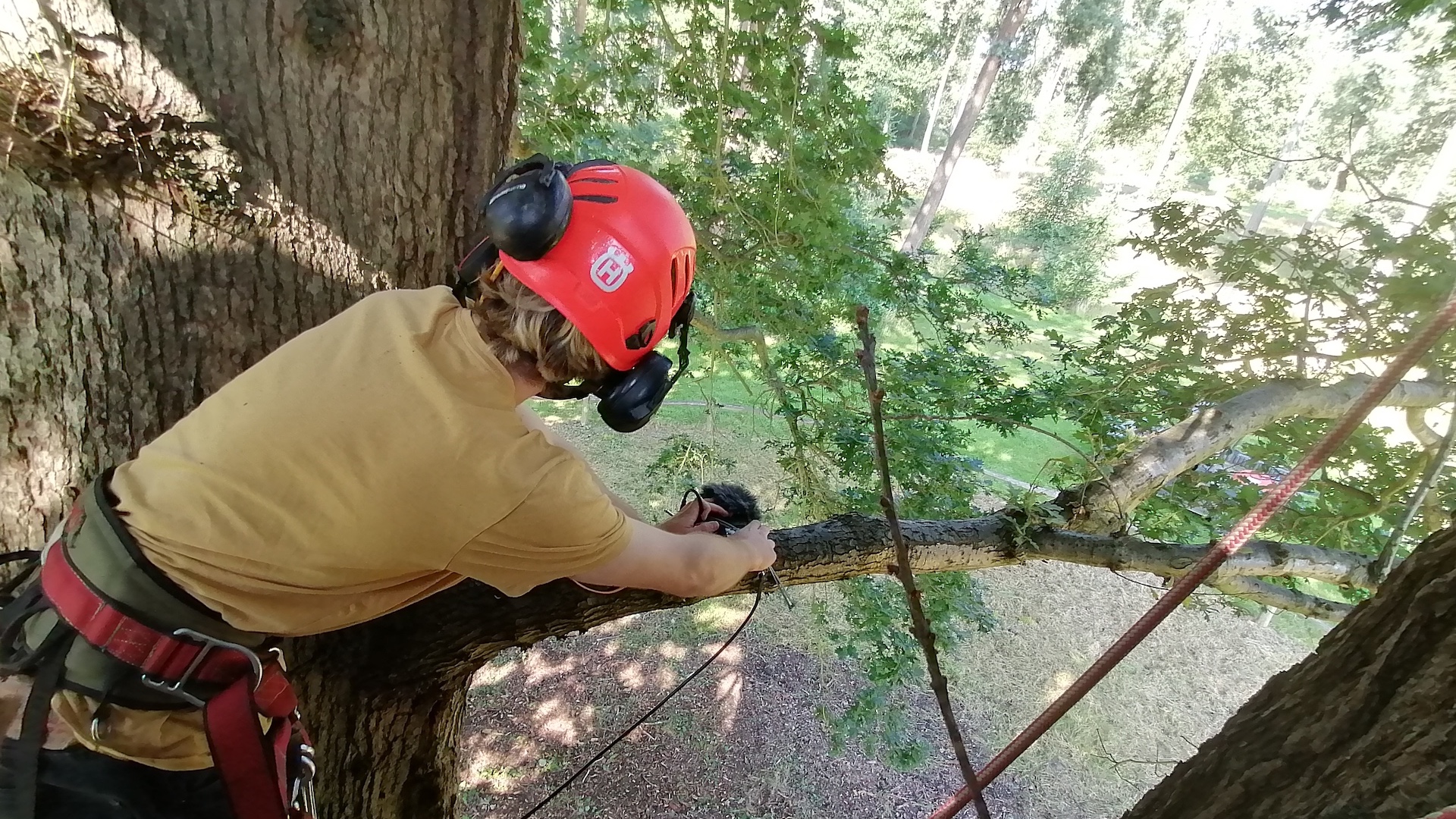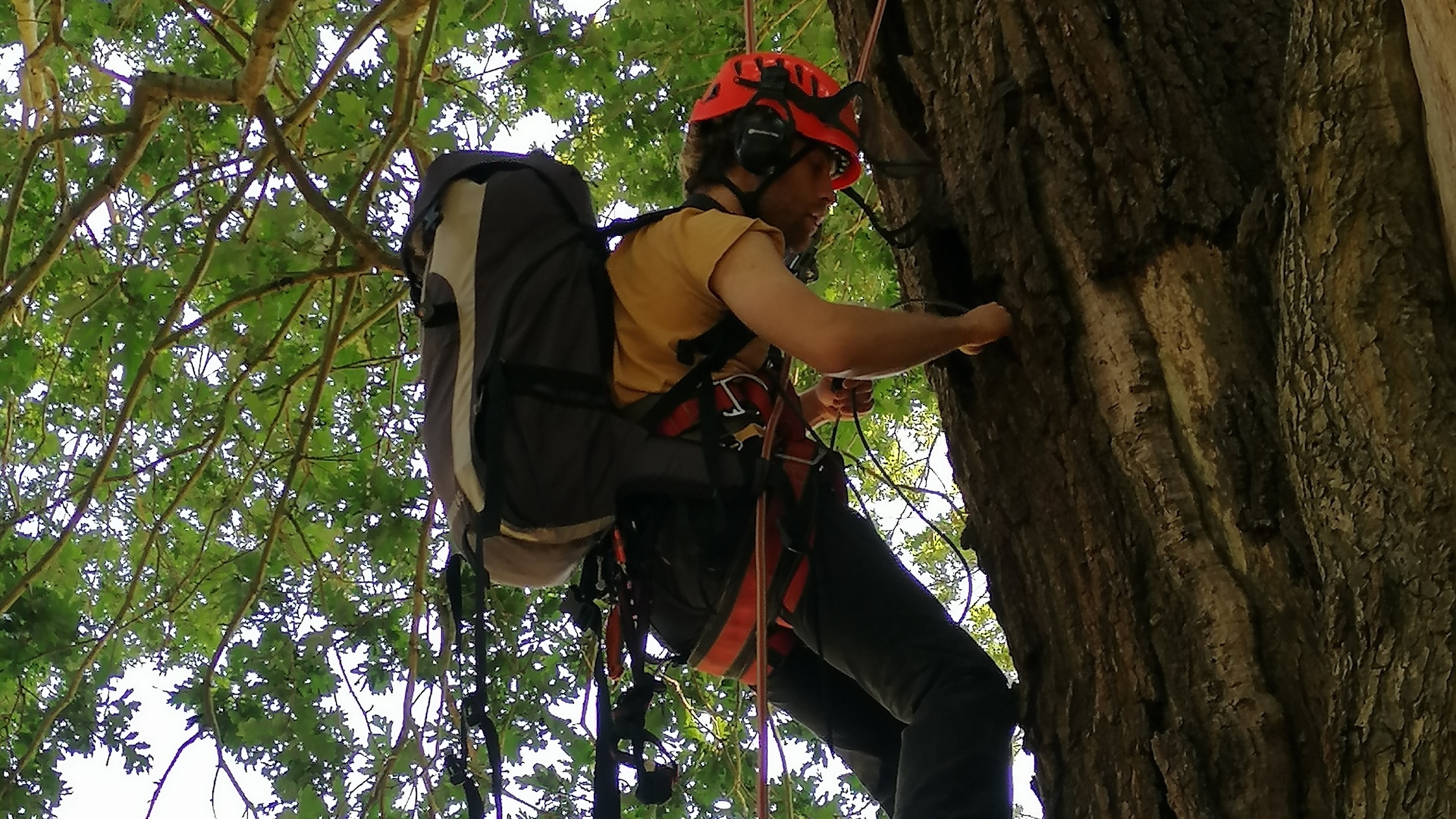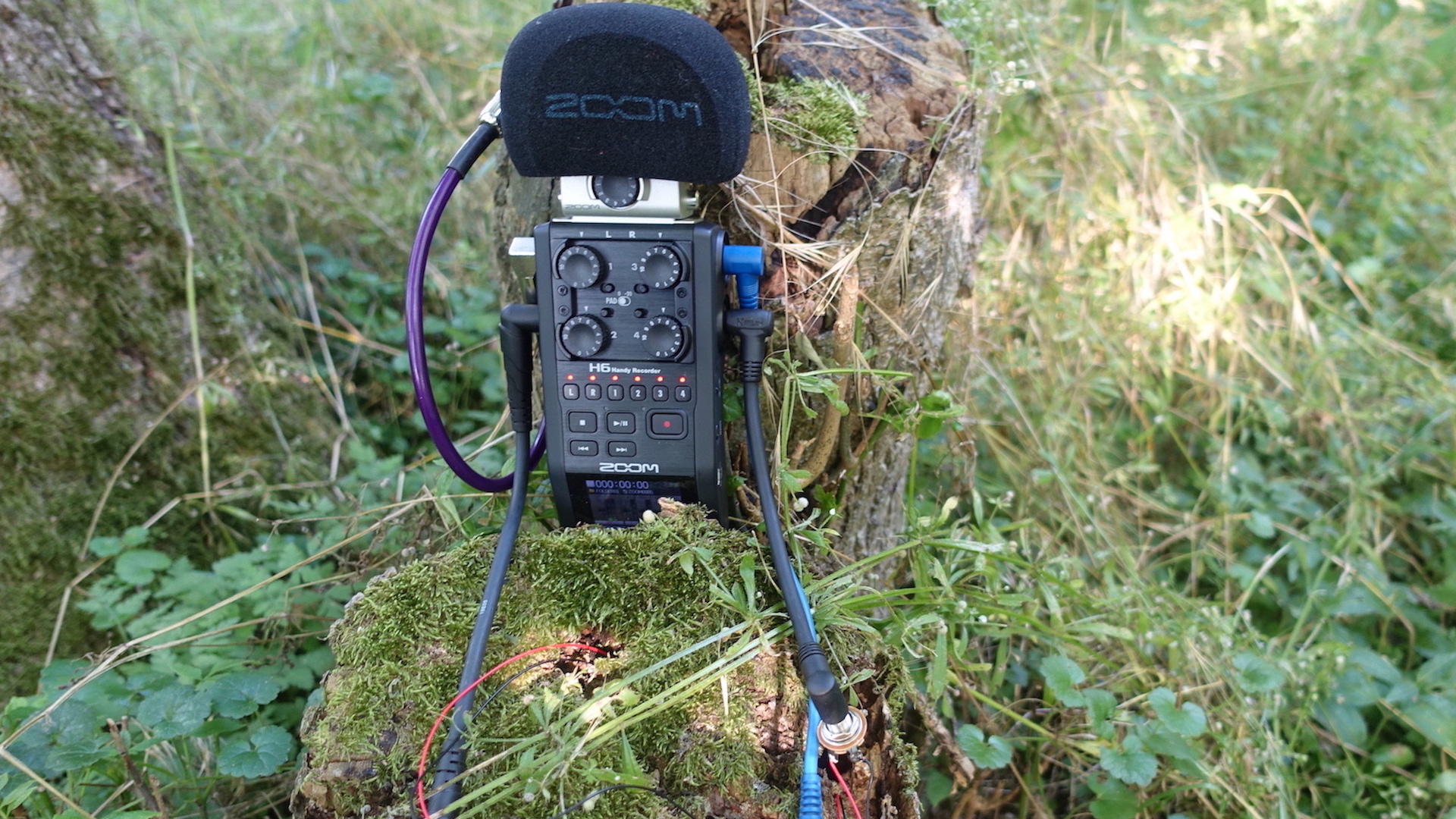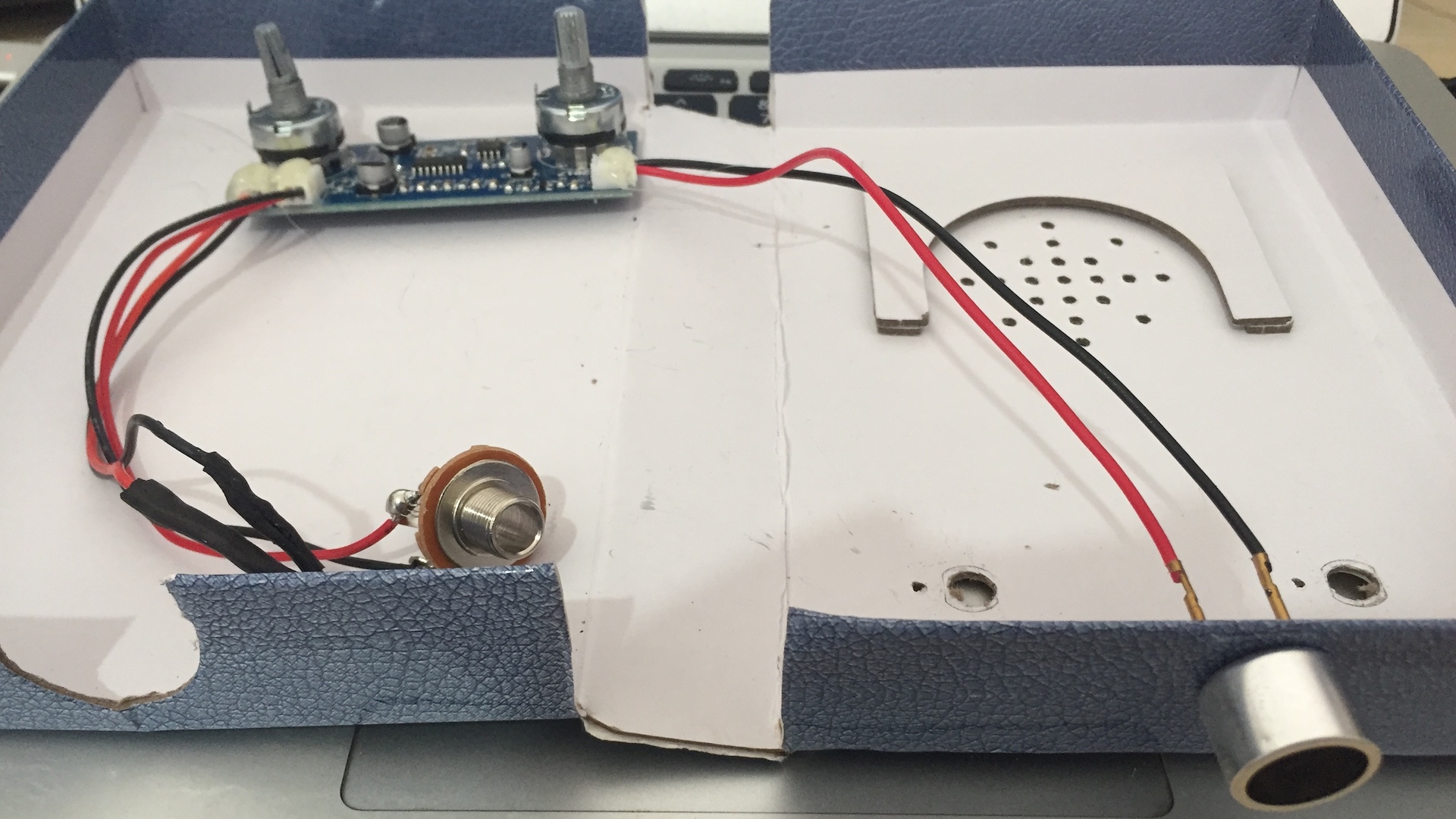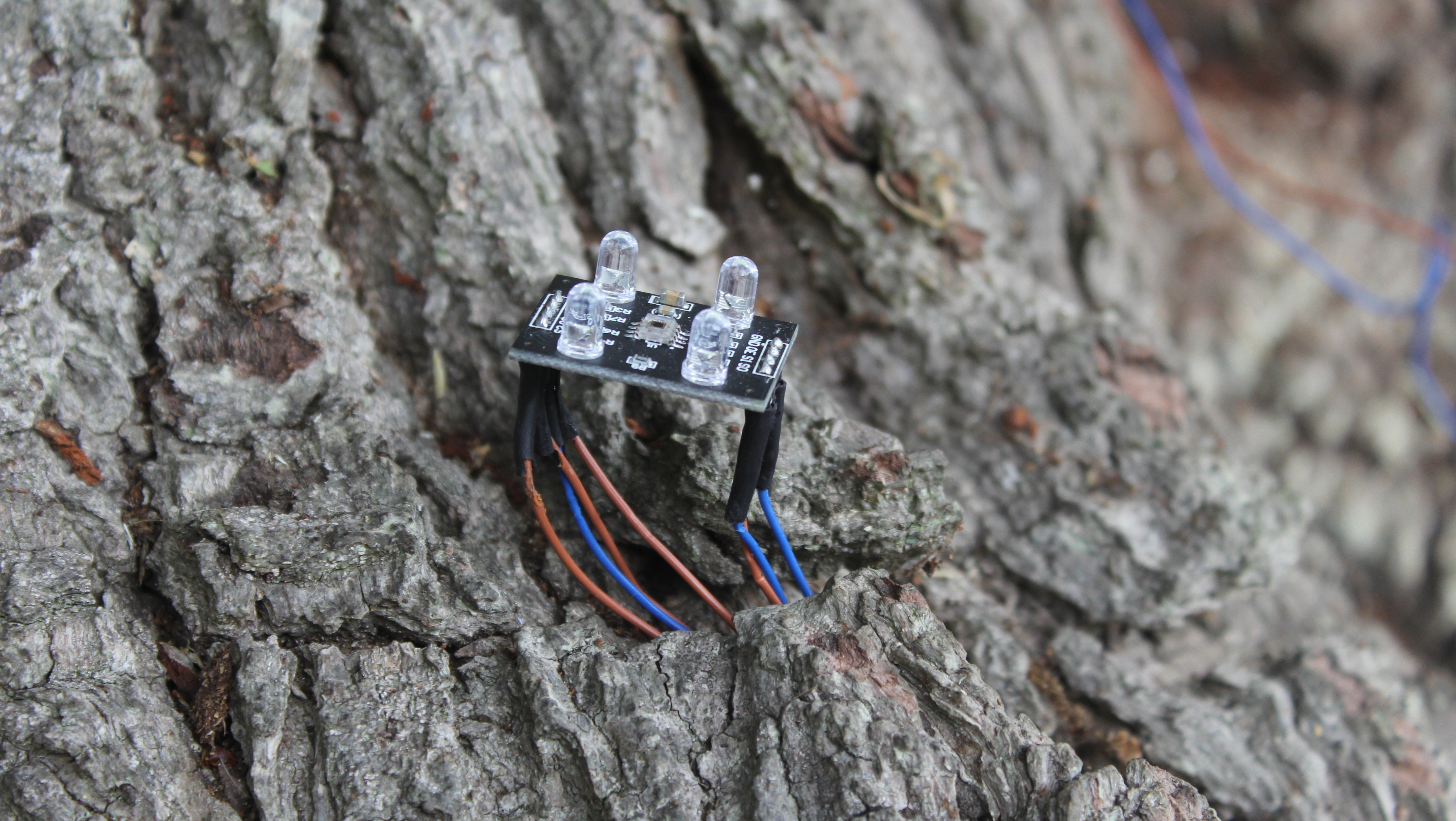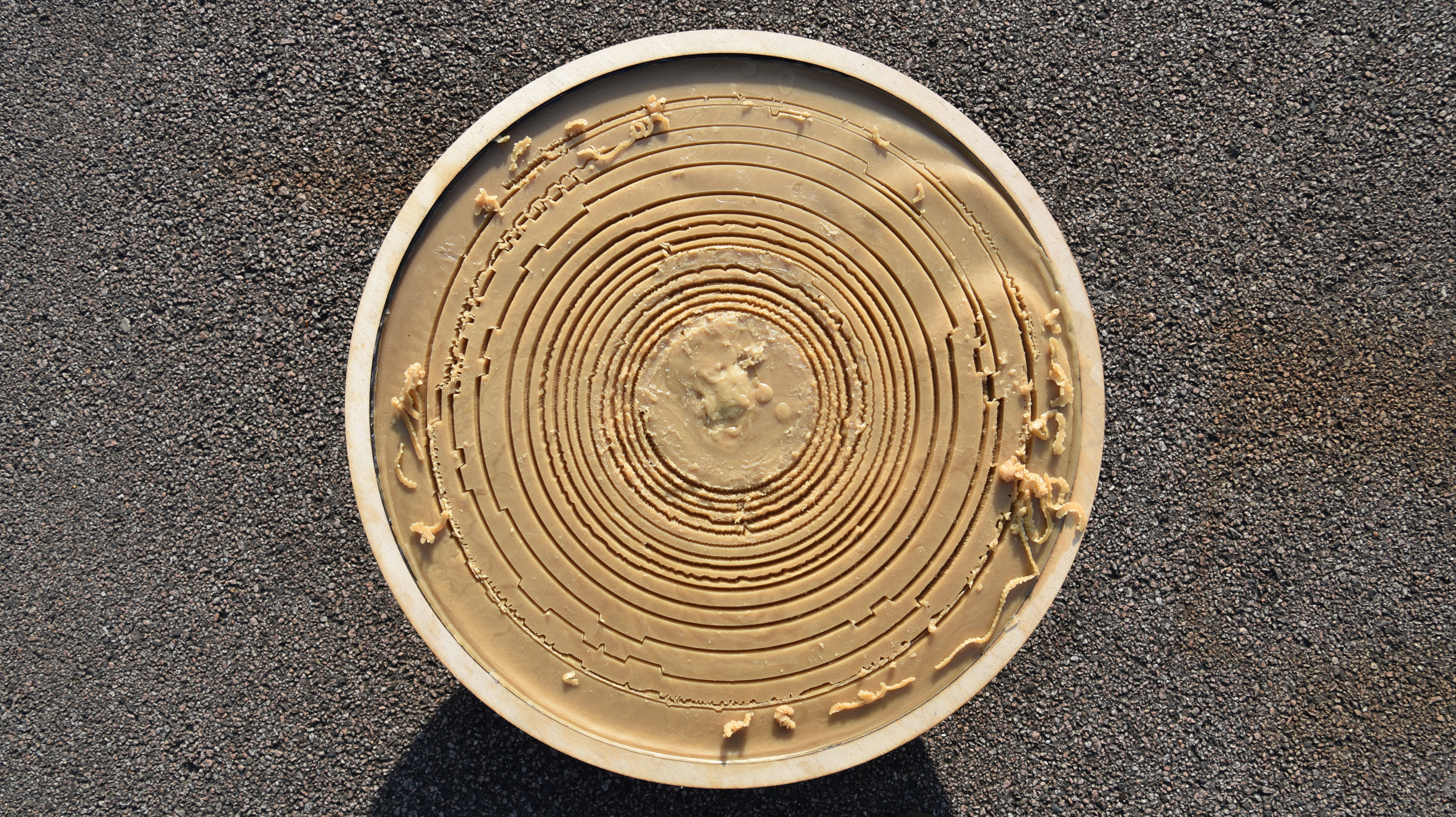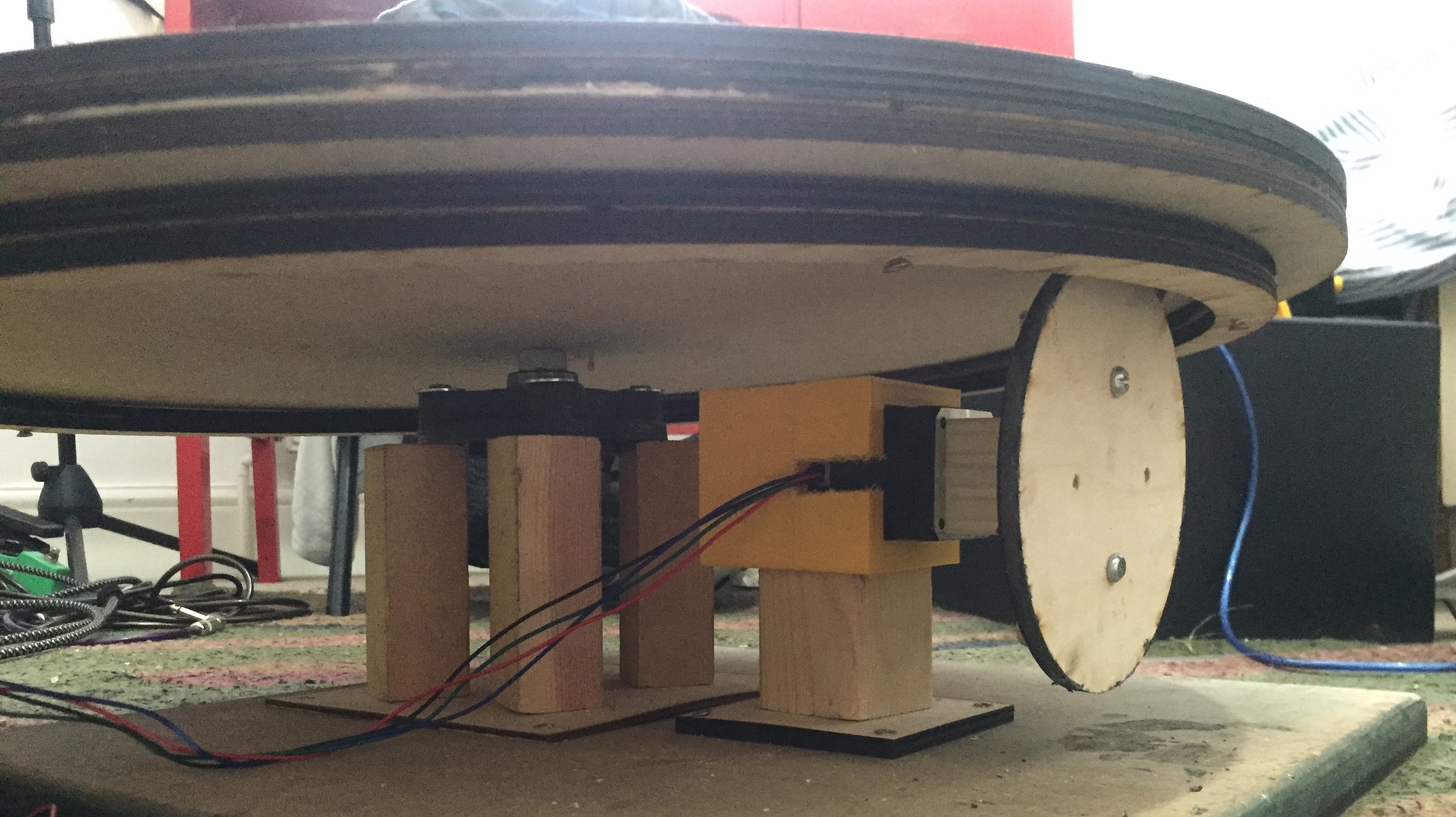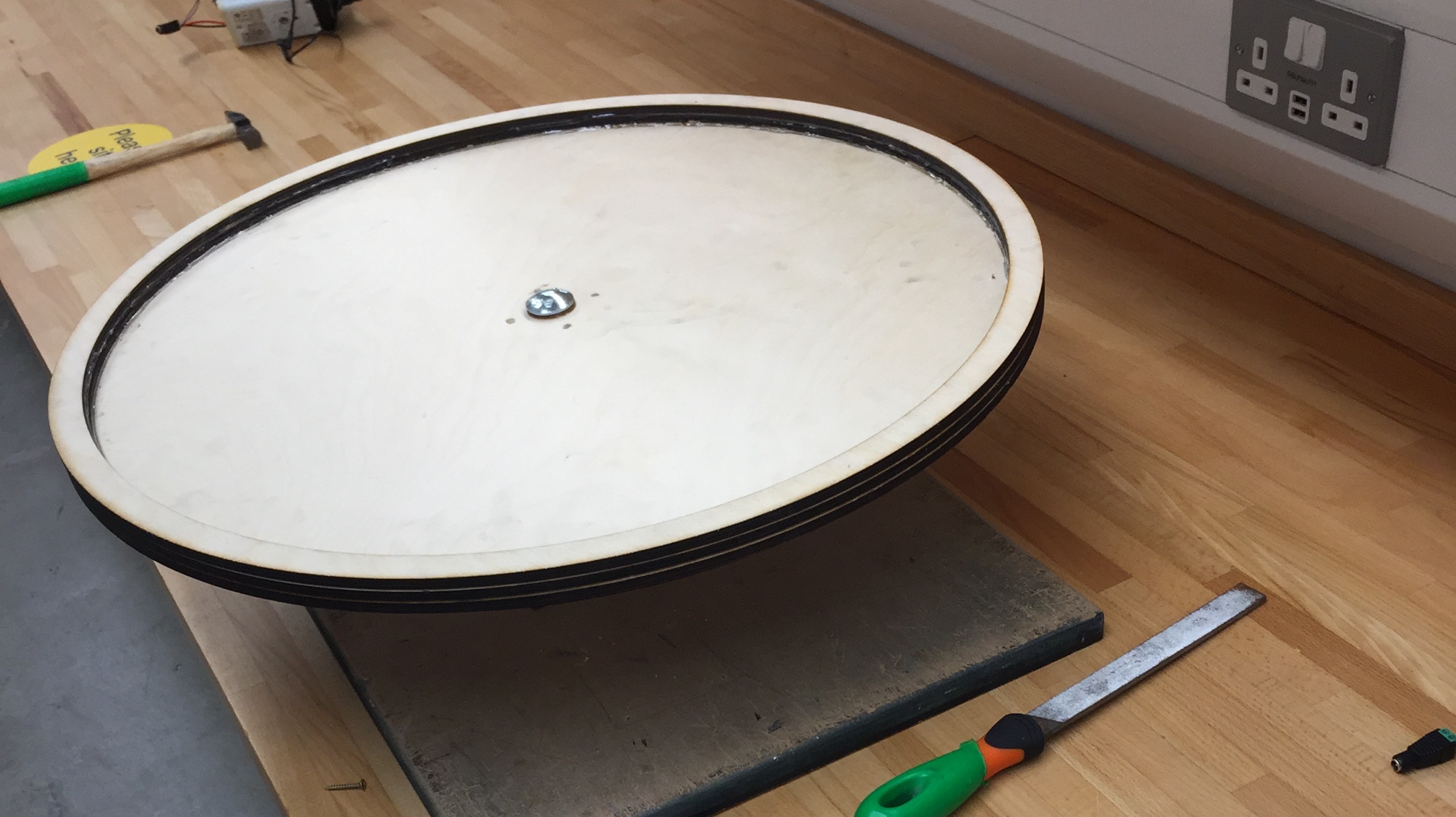Sonic Tree (Fungal Record)
Combining remote data from oak trees in Essex and audio recordings from inside the 900 year old Honeywood Oak, Sonic Tree engages with trees through sound, whilst also marking slow, unnoticed processes occurring in trees and the underground fungal networks that connect them to each other.
produced by: Lou Terry
Articulating Environments Through Sound
Sonic Tree is rooted in my wider area of research into environmental and ecological sensing, looking specifically at how the ways in which we choose to sense environments/ecologies govern our approaches to challenges they present, as well as how we see ourselves in relation to them. Throughout this research I have suggested sound as a rich medium for articulating environments and the non-human actors within them. Sound traces a history of relations, echoing and reflecting states of landscapes, traversing micro/macro scales of space and time, and recomposing itself through living beings in the expressive form of voice. Vocalizations reterritorialize living beings in space, they are an ontological test of one’s location, role and value in the world; a ‘here I am’ of something there (Pettman, 54). In this way, sound binds us to environments, helping us see (or hear) them not as external entities to be counted or measured, but as something lived and felt, that therefore we too are always already a part of, and co-produced alongside. For a more in depth discussion see my paper ‘Feral Robotic Birds’ in Cadernos de Arte Antropologia (Terry, 2021).
The Honeywood Oak
My other, more immediate inspiration for this project was James Canton’s The Oak Papers, in which he documents visits to the 900 year old Honeywood Oak in Essex. This oak is incredibly biodiverse, partly thanks to the unchanging ecosystem of its inner rot wood, protected for centuries by thick bark. Over 1000 species of insects, birds, mammals and fungi depend on it. I wanted to capture this biodiversity sonically, so that through my work, a hidden living world is revealed.
I contacted James who put me in touch with various arborists and tree enthusiasts. Talking with these experts was key in learning what sounds and data might be recordable, and how, when and where to record them. Among other recording trips, I arranged a 24 hour camping trip to record sounds at the Honeywood Oak. An arborist accompanied me with ropes and belays into the oak’s palm, and across various faces and cavities of its enormous branches and trunk. I placed field recording mics, home-made and purchased contact mics, a hacked ultrasonic mic, and a portable mic I made from a solar powered raspberry Pi. From the tree’s inside I recorded bark beetles, ants, wood mice, hornets, click beetles, weevils, and the tree’s own sounds of internal water and sap movements. From around the tree I recorded pipistrelle bats, crickets, humans, muntjac deer and various birds.
Images 1 - 3: Placing mics in the Honeywood Oak. Image 4: Mic from Raspberry Pi, Audio Injector and Octo sound card Image 5: Zoom H6 and contact mics in stump. Image 6: Hacked ultrasonic mic with piezo buzzer and 1/4" audio output. Image 7: Homemade contact mic.
I arranged these sounds in a sonic installation whose diurnal dramaturgy is dictated by the time of day and which species are present at that time. Visitors can hear bats at dusk only, and the dawn chorus during morning visits, for instance.
Arboreal Processes, Fungi and Time
Further research led me to books by Suzanne Simard, Peter Wohlleben and Merlin Sheldrake, where I learnt that trees are intelligent and communicative beings, exchanging nutrients, warning one another of diseases, and nurturing their offspring. Their symbiotic relationships with fungi, whose mycorrhizal networks, coined the ‘wood wide web’, make possible this cooperative behaviour.
People think of trees as being intelligent and social. Trees are selected and planted for quick trunk growth for wood, not left to grow ancient, where microclimates maintained by forest canopies and soil retained by roots could develop into biodiverse ecosystems. Trees planted on roadsides to inhale fumes are cut should their roots grow too far and damage water pipes or pavements. These trees are alone, off-grid from the communicative wood wide web.
Thus it was important to present trees as living beings, as a networked forest. I needed to mark slow arboreal processes over time, which the ephemeral nature of sound struggled to capture. I built the central rotating wax disc, whose soft surface is engraved upon by a robotic arm. Live electrical data from fungi living in an oak in the nearby Page’s Covert (where artist Lily Hunter granted me access) is captured by electrodes connected to an Adafruit ESP32, sent via web sockets to a Glitch server, which is received via websockets in the gallery through node.script in Max, and finally sent from Max to arduino via Serial, to control the arm's jagged, wavelike etchings. This electrical data is connected to the tree’s exchanges with the fungus. Live light data from a green colour sensor and an LDR also controls a servo via the same process, which determines the groove's depth. The Adafruit is powered with a lithium battery, solar panel and is kept in a dry box and bag for weather protection.
Image 1: Electrodes on bracket fungus. Image 2: Colour sensor. Image 3: LDR. Image 4: Solar panel with lithium battery and dry bag. Image 5: Technical configuration of Adafruit --> Glitch --> Max --> Arduino and speakers
Over the exhibition’s five days, the arm increments gradually from the disc’s centre to its outer rim, creating concentric rings. Much like rings on a tree trunk, which yield information about the tree’s conditions over time, these rings tell us something about the tree’s existence over these five days, about its communications and exchanges with other trees in the wood via the fungus. The markings allow us to perceive processes occurring on timescales we might not hear when listening to the piece. Large changes are imperceptible on one visit, and yet, the rings still form faster than a tree’s, which are annual. Thus, instead of simply moulding arboreal processes to anthropological timescales, the work sits halfway between human/tree, allowing us to perceive process (just), whilst forcing us to slow ourselves closer to a tree’s sense of time. The cylinder’s position also decentres the (human) viewer/listener, so that we are never central, but always moving round.
The ephemeral nature of sound captures these processes more subtly, with light and fungal data controlling volume and delays. Delay repeats and feedback occur over long periods, creating layers of sounds. In this way long-form processes are sonified despite sound’s ephemeral nature, as layers are sensed simultaneously, like geological sediments. The connection between long-form processes and sound is subtly suggested by the wax disc, which resembles a trunk’s cross section, a clock, and an LP (Long Player) record.
Image 1-2: Robotic arm and rotating wax disc, with arduino, CNC sheild, laptop, amplifiers, audio interface and cabling hidden in black casing made from cut and painted plints. Image 3: 8 speaker configuration (4 Genelex selected for sound quality and bass response, and 4 homemade speakers from Oliver Schilke, selected for aesthetic quality and complimenting treble response.)
Reflection and Further Developments
I’m pleased I succeeded in a high-risk project. Sounds were difficult to obtain, with multiple recording trips necessary to capture them. The wheel had to turn flatly and smoothly, and the wax’s weight could not overwork the stepper motor, spinning the wheel underneath via a cog. I had to melt and pour the wax into a fully sealed wheel to prevent leakage. The wax and softening solution’s consistency had to be soft enough for engraving and the chisel could not cause too much drag. The data stream could also fail, and its remote location added further risk. I collected a 24 hour long backup data set that Max reverts to when the live server disconnects. I programmed Max to jump to the relevant index of backup data dependent on daytime (if the server disconnects at 2.15pm, backup data from 2.15pm replaces it). Some inconsistencies occurred between the live and backup streams when wifi disconnected, and sometimes values jumped because of this, or were of different character from previous data, creating more digital, square wave patterns. Interestingly, the disc has become a record also of the technology through which the tree and fungi have been mediated.
Image 1: Rings after 5 days, marking both the tree's exchanges with fungi, and also the technological processes they are mediated through. Image 2: The wheel mechanics, consisting of a stepper motor on a 3d printed bass, with a 3D printed attachment for a laser cut wooden cog. Wheel bolted to large bearing, supported by wooden supports and base. Image 3: Wheel prior to wax. Image 4: Arduino and CNC shield in 3D printed casing, with attached fan and power output.
Another aspect I worked very hard on was a live audio streamer with a solar powered Raspberry Pi and sound card, so that some sound could be live, like the data. I successfully made an audio streamer but was not able to place this at the Honeywood Oak during the exhibition as the arborist and arboretum head were on annual leave, nor did I have the budget for a dongle and 3G to Wifi converter. Page’s Covert had wifi, but it is by busy roads, and these sounds were not part of what I wanted to convey, distanced from the wood’s ecosystem, just loud.
The sensed data (fungi and coloured light) were only a few of many data I considered capturing. These involved olfactory communication methods between trees, such as phytoncide pheromones, which I researched recording via quartz crystals. The scientific equipment needed to achieve this was beyond this project’s scope, but it interests me. Another was the way branches rise and fall, sometimes metres, as the tree ‘wakes’ and ‘sleeps’, or branches swelling and dilating with water. New roots also murmur at 220Hz, and this would be great to capture sonically if I could find a way that wouldn’t damage the topsoil. I would also like to make iterations of the wheel, with different trees, in different climates, at different times of year. I could make prints from the resultant wax, or even cut vinyl records from it, in an interesting process of encoding and decoding the data and sound.
Annotated Bibliography of Inspirational Sound and Art Works
Dunn, David. 2006. “The Sound of Light in Trees”. Earth Ear. Available at http://earthear.com/dunn.html
Gan, Elaine and Anna Tsing. 2012. “A Fungal Clock: Experiments in Representing Time” Annual Meeting of the American Anthropology Association. Available at https://www.elainegan.com/fungalClock.html
An example of multispecies artwork that allows us to get on board with nonhuman timescales and modes of consciousness, between pine, oak, human and matsutake mushrooms.
Green, Lily Hunter. 2019. “Bee Composed”. Available at https://lilyhuntergreen.com/work/bee-composed-live/
I contacted Lily Hunter Green early on, who makes sound and visual works that involve streaming. We bounced technical and conceptual considerations with one another. She also let me record and set up the data streaming device in her wood, Page’s Covert.
Locus Sonos. 2006-2021. “Locustream Soundmap | Live Worldwide Open Microphones”. Available at https://locusonus.org/soundmap/051/
Maeder, Marcus. 2016. “Trees: Pinus sylvestris". Available at https://www.researchcatalogue.net/view/215961/215962
This piece uses both acoustic recordings of tree, and sonified data to create a sonic installation on trees and their responses to environmental conditions. I followed their instructions and made DIY ultrasonic mics by soldering copper wire pins on piezo buzzer elements, which if stuck into the wood, pick up ultrasonic cavitation pulses. However after conversations with tree expert Rory Hobbs, I was told this could be damaging for trees, so I didn’t use this method.
Mileece. 2014. “Meet the Sonic Artist Making Music with Plants: Sound Builders”. Available at https://www.youtube.com/watch?v=wYU18eiiFt4.
I used the same principle of using electrodes, to gather electrical potentials from fungi.
Metcalfe, Alex. 2007. “Tree listening project”. Available at https://www.treelistening.co.uk/
Recording the internal water movements of trees was very difficult. I tried using stethoscopes many times but was unsuccessful. I researched Alex Metclafe's tree listening device (contact mic in a horn shaped vessel, with a noise reducer and amplifier). Although he did not respond to my communications, I managed to fashion my own with contact mics, with digital amplification and noise reduction, and actually managed to get clearer and richer recordings than those captured by Metcalfe’s device.
Winderen, Jana. 2016. “The Listener” Ash International. Available at https://www.janawinderen.com/releases/the-listener
Research Bibliography
Butler, Simon. 2021. ”Listening to the data: the shifting sounds of spring”. Online Zoom talk organised by Colchester Natural History Society.
Canton, James. 2020. The Oak Papers. Edinburgh: Canongate Books Ltd.
Calvo, Paco. 2016. “The Philosophy of Plant Neurobiology: A Manifesto”. Minimal Intelligence Lab (MINT Lab), Synthese 193: 1323.
Gabrys, Jennifer. 2013. Program Earth: Environmental Sensing Technology and the Making of a Computational Planet. Minneapolis: University of Minnesota Press.
Gagliano, Monica. 2017. “The Mind of Plants: Thinking the Unthinkable”. Communicative and Integrative Biology 10:2.
López, Francisco. 2019. Sonic Creatures. Available at http://www.franciscolopez.net/pdf/creatures.pdf
Mitachi et al. “Odor Sensing in Natural Environment Using Quartz Crystal Resonators: Application to Aroma Sensing of Roses Cultivated in an Outside Garden”. School of Bionics, Tokyo University of Technology 1404-1 Katakura, Hachioji, Tokyo 192-0982 Japan. Available at https://wwwlib.teiep.gr/images/stories/acta/Acta%20679/679_13.pdf
Pettman, Dominic. 2017. Sonic Intimacy: Voice, Species Technics (or, How to Listen to the World). California: Stanford University Press.
Simard, Suzanna. 2021. Finding the Mother Tree. London: Penguin.
Sheldrake, Merlin. 2021. Entangled Life: How Fungi Make Our Worlds, Change Our Minds & Shape Our Futures. New York: Random House.
Terry, Lou. 2021. “Feral Robotic Birds”. Cadernos de Arte e Antropologia. Antropoceno Sónico – Práticas Sonoras para um Ambiente em Mudança. 48-60.
Wohlleben, Peter. 2015. The Hidden Life of Trees: What They Feel, How They Communicate: Discoveries from a Secret World. London: William Collins.
Wohlleben, Peter. 2021. The Heartbeat of Trees. London: Greystone Books.
Code/Tutorials Used
Watson, Reginald. 2018. “How to Build an Internet Radio Station With Raspberry Pi, Darkice, and Icecast”. Available at https://maker.pro/raspberry-pi/projects/how-to-build-an-internet-radio-station-with-raspberry-pi-darkice-and-icecast?fbclid=IwAR3rRE___i1rzo0SHCzfGiSwMml7-DEH7SMgfzW88himFno_l183j_F5FPw
This tutorial showed me how to make a Raspberry Pi into an internet radio station (which can also be used as a live audio streamer from the tree).
Brown, Andrew R. 2020. “Audio Input and Writing Sound Files in Pure Data”. Available at
https://www.youtube.com/watch?v=g91oaJlxPuE
I adapted this code to create a 6 input audio recorder to be used in conjunction with a Raspberry Pi and Audio Injector Octo soundcard.
DIY Machines. 2020. “Super Easy 3D Printed Arduino CNC Drawing Machine”. Available at https://www.youtube.com/watch?v=XYqx5wg4oLU
I followed this tutorial to build my CNC plotter. I used my own code to control it.
Sethi et al. 2021. “Ecosystem monitoring, made easy: Robust, real-time and autonomous monitoring of ecosystems with an open, low-cost, networked device”. Available at https://sarabsethi.github.io/autonomous_ecosystem_monitoring/
This was my blueprint for the manual set-up of an ecosystem monitoring device using a Raspberry Pi that was waterproofed and solar powered, and securely attached to a tree. I did not use their Raspberry Pi image or code. I used this manual configuration to power and protect the Adafruit ESP32 and sensors (electrodes, colour sensor, LDR and temperature sensor), as well as for the Raspberry Pi audio recorder, and will use it for my Pi audio streamer.
































































